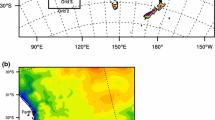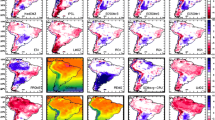Abstract
We present an analysis of climate change over Europe as simulated by a regional climate model (RCM) nested within time-slice atmospheric general circulation model (AGCM) experiments. Changes in mean and interannual variability are discussed for the 30-year period of 2071–2100 with respect to the present day period of 1961–1990 under forcing from the A2 and B2 IPCC emission scenarios. In both scenarios, the European region undergoes substantial warming in all seasons, in the range of 1–5.5°C, with the warming being 1–2°C lower in the B2 than in the A2 scenario. The spatial patterns of warming are similar in the two scenarios, with a maximum over eastern Europe in winter and over western and southern Europe in summer. The precipitation changes in the two scenarios also show similar spatial patterns. In winter, precipitation increases over most of Europe (except for the southern Mediterranean regions) due to increased storm activity and higher atmospheric water vapor loadings. In summer, a decrease in precipitation is found over most of western and southern Europe in response to a blocking-like anticyclonic circulation over the northeastern Atlantic which deflects summer storms northward. The precipitation changes in the intermediate seasons (spring and fall) are less pronounced than in winter and summer. Overall, the intensity of daily precipitation events predominantly increases, often also in regions where the mean precipitation decreases. Conversely the number of wet days decreases (leading to longer dry periods) except in the winter over western and central Europe. Cloudiness, snow cover and soil water content show predominant decreases, in many cases also in regions where precipitation increases. Interannual variability of both temperature and precipitation increases substantially in the summer and shows only small changes in the other seasons. A number of statistically significant regional trends are found throughout the scenario simulations, especially for temperature and for the A2 scenario. The results from the forcing AGCM simulations and the nested RCM simulations are generally consistent with each other at the broad scale. However, significant differences in the simulated surface climate changes are found between the two models in the summer, when local physics processes are more important. In addition, substantial fine scale detail in the RCM-produced change signal is found in response to local topographical and coastline features.














Similar content being viewed by others
References
Beniston M (2004) The 2003 heat wave in Europe: a shape of things to come? An analysis based on Swiss climatological data and model simulations. Geophy Res Lett 31(2):L02202. DOI 10.1029/2003GL018857
Christensen JH, Christensen OB (2003) Climate modelling: severe summertime flooding in Europe. Nature 421:805–806
Christensen JH, Carter TR, Giorgi F (2002) PRUDENCE employs new methods to assess European climate change. EOS 83:147
Cubasch U, Meehl GA, Boer GJ, Stouffer RJ, Dix M, Noda A, Senior CA, Raper S, Yap KS (2001) Projections of future climate change. In: Houghton JT, Ding Y, Griggs DJ, Noguer M, van der Linden PJ, Dai X, Maskell K, Johnson CA (eds). Climate change 2001; the scientific basis, contribution of working group I to the third assessment report of the intergovernmental panel on climate change (IPCC) chapt. 9. Cambridge University Press, Cambridge, pp 525–582
Edwards AL (1984) An introduction to linear regression and correlation. WH Freeman and Co., New York, pp 81–83
Ekman AML, Rodhe H (2003) Regional temperature response due to indirect sulfate aerosol forcing: impact of model resolution. Clim Dynam 21:1–10
Giorgi F, Marinucci MR (1996) Improvements in the simulation of surface climatology over the European region with a nested modeling system. Geophys Res Let 23:273–276
Giorgi F, Mearns LO (1999) Introduction to special section: regional climate modeling revisited. J Geophys Res 104:6335–6352
Giorgi F, Mearns LO (2002) Calculation of average, uncertainty range and reliability of regional climate changes from AOGCM simulations via the “Reliability Ensemble Averaging (REA)” method. J Clim 15:1141–1158
Giorgi F, Marinucci MR, Visconti G (1992) A 2XCO2 climate change scenario over Europe generated using a limited area model nested in a general circulation model II: climate change scenario. J Geophys Res 97:10011–10028
Giorgi F, Marinucci MR, Bates GT (1993a) Development of a second generation regional climate model (RegCM2). Part I: boundary-layer and radiative transfer processes. Mon Wea Rev 121:2794–2813
Giorgi F, Marinucci MR, Bates GT, De Canio G (1993b) Development of a second generation regional climate model (RegCM2). Part II: convective processes and assimilation of lateral boundary conditions. Mon Wea Rev 121:2814–2832
Giorgi F, Hurrell JW, Marinucci MR, Beniston M (1997) Elevation signal in surface climate change: a model study. J Clim 10:288–296
Giorgi F, Whetton PW, Jones RG, Christensen JH, Mearns LO, Hewitson B, vonStorch H, Francisco R, Jack C (2001) Emerging patterns of simulated regional climatic changes for the 21st century due to anthropogenic forcings. Geophys Res Lett 28: 3317–3320
Giorgi F, Bi X, Qian Y (2002) Direct radiative forcing and regional climatic effects of anthropogenic aerosols over East Asia: a regional coupled climate-chemistry/aerosol model study. J Geophys Res 107:4439. DOI 10.1029/2001JD001066
Giorgi F, Bi X, Qian Y (2003a) Indirect vs. direct effects of anthropogenic sulfate on the climate of East Asia as simulated with a regional coupled climate-chemistry/aerosol model. Climatic Change 58:345–376
Giorgi F, Bi X, Pal JS (2004) Mean, interannual variability and trends in a regional climate change experiment over Europe. I: present day climate (1961–1990). Clim Dyn 22:733–756
Huntingford C, Jones RG, Prudhomme C, Lamb R, Gash JHC, Jones DA (2003) Regional climate model predictions of extreme rainfall for a changing climate. Q J R Meteorol Soc 129:1607–1622
IPCC (2000) Emission scenarios, a special report of working group III of the intergovernmental panel on climate change. Nakicenovic N, Coordinating Lead Author, Cambridge University Press, Cambridge, p 599
Johns TC, Gregory JM, Ingram WJ, Johnson CE, Jones A, Mitchell JFB, Roberts DL, Sexton DMH, Stevenson DS, Tett SFB, Woodage MJ (2001) Anthropogenic climate change for 1860 to 2100 simulated with the HadCM3 model under updated emission scenarios. Hadley Centre Technical Note no. 22, p 62
Jones RG, Murphy JM, Hassell D, Taylor R (2001) Ensemble mean changes in a simulation of the European mean climate of 2071–2100 using the new Hadley Centre regional modeling system HadAM3H/HadRM3H. Hadley Centre report, p 19
Jones RG, Murphy JM, Noguer M, Keen M (1997) Simulation of climate change over Europe using a nested regional climate model. I: comparison of driving and regional model responses to a doubling of carbon dioxide. Q J R Meteorol Soc 123:265–292
Leung LR, Ghan SJ (1999) Pacific Northwest climate sensitivity simulated by a regional climate model driven by a GCM. Part II: 2XCO2 simulations. J Clim 12:2031–2053
Loveland TR, Merchant JW, Ohlen DO, Brown JF (1991) Development of a land cover characteristics database for the conterminous United States. Photogrammetric Eng Remote Sensing 57:1453–1463
Mitchell JFB, Johns TC, Eagles M, Ingram WJ, Davis RA (1999) Towards the construction of climate change scenarios. Clim Change 41:547–581
Pal JS, Small EE, Eltahir EAB (2000) Simulation of regional—scale water and energy budgets: representation of subgrid cloud and precipitation processes within RegCM. J Geophys Res 105:29579–29594
Pope VD, Gallani ML, Rowntree PR, Stratton RA (2000) The impact of new physical parameterisations in the Hadley Centre climate model. Clim Dynam 16:123–146
Räisänen J, Joelsson R (2001) Changes of average and extreme precipitation in two regional climate model experiments. Tellus A 53:547–566
Räisänen J, Rummukainen M, Ullerstig A (2001) Downscaling of greenhouse gas induced climate change in two GCMs with the Rossby Centre regional climate model for northern Europe. Tellus A 53:168–191
Räisänen J (2002) CO2-induced changes in interannual temperature and precipitation variability in 19 CMIP2 experiments. J Clim 15:2395–2411
Räisänen J, Hansson U, Ullerstig A, Döscher R, Graham LP, Jones C, Meier HEM, Samuelsson P, Willen U (2004) European climate in the late twenty-first century: regional simulations with two driving global models and two forcing scenarios. Clim Dynam 22:13–31
Schär C, Vidale PL, Luthi D, Frei C, Haberli C, Liniger MA, Appenzeller C (2004) The role of increasing temperature variability in European summer heatwaves. Nature 427:332–336
vonStorch H, Zwiers FW (1999) Statistical analysis in climate research. Cambridge University Press, Cambridge, p 484
Acknowledgements
This work was supported by the European Union Programme Energy, Environment and Sustainable Development under contract EVK2-2001-00156 (PRUDENCE). We would like to thank the Hadley Centre for providing the HadAM3H data. We also thank two reviewers for their insightful comments which helped to improve the quality of the paper.
Author information
Authors and Affiliations
Corresponding author
Rights and permissions
About this article
Cite this article
Giorgi, F., Bi, X. & Pal, J. Mean, interannual variability and trends in a regional climate change experiment over Europe. II: climate change scenarios (2071–2100). Climate Dynamics 23, 839–858 (2004). https://doi.org/10.1007/s00382-004-0467-0
Received:
Accepted:
Published:
Issue Date:
DOI: https://doi.org/10.1007/s00382-004-0467-0




